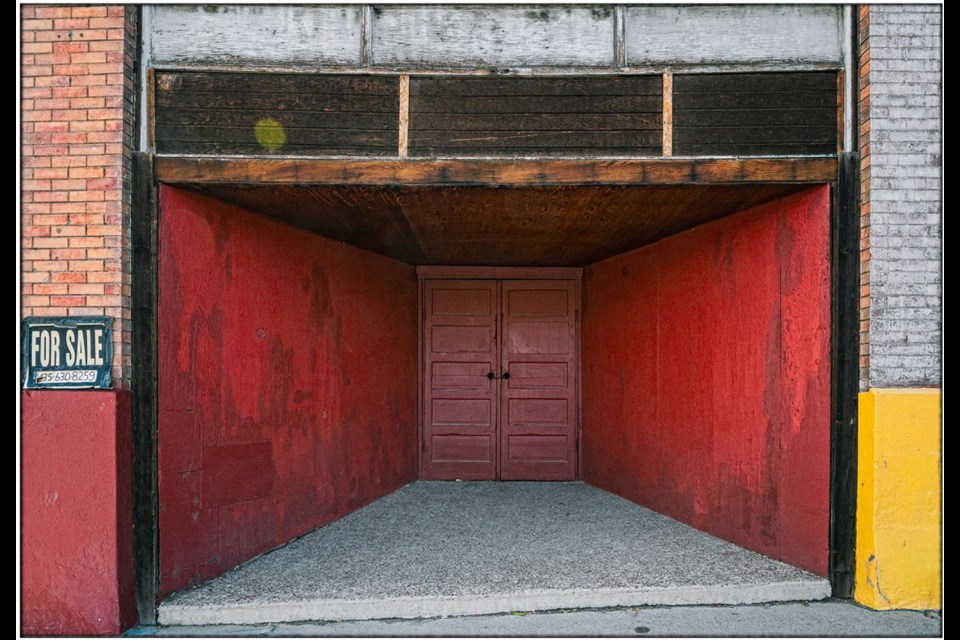 I walked into the Gage Gallery (2031 Oak Bay Ave., 250-592-2760) to catch the last days of a show of photographs by Francis Sullivan and Cameron Kuntz.
I walked into the Gage Gallery (2031 Oak Bay Ave., 250-592-2760) to catch the last days of a show of photographs by Francis Sullivan and Cameron Kuntz.
Kuntz has a number of closeups of rusting iron, good professional work, but it was the roadside scenes by Sullivan that drew me in. Sullivan is a professional custom printer of photography, and last year I employed him to create new prints from old photographs for my exhibition of the work of Harold Mortimer-Lamb (francissullivanphoto.com). Sullivan’s skill brought a velvety lustre and a sensitive period tone to what had sometimes been pretty scrappy prints.
One of Sullivan’s prints in Gage Gallery’s front window caught my eye. It showed a tumbledown roadside shed, roughly painted with the stars and stripes motif. Written across the top of the wall were the words “ill eagle.” Somehow that sort of sums up Francis Sullivan’s road trip in America.
He’s driving along, and something catches his eye. The Human Impact, he calls it. So he stops, and gets out for a closer look.
“The camera is the means of my interaction with the world,” Sullivan explained. “I’m interested in the human side of the landscape.” Signs are the key, and all of them have stories.
For example, he was in a small town in Oregon, poking around with his camera outside a junkyard. A “police car” with a hand-painted star was stuck up on a pole on the roadside. The proprietor met him, and they spent an hour on a little photo safari.
“Have you seen the Jesus on the bus?” the owner eventually asked, and led Sullivan to a rusted hulk where a decal of Jesus’ face was fading into the bus’s body.
“What I do is a sort of portraiture,” Sullivan told me, “and I see it in places and things where others don’t see any value.”
We got talking about the paintings of Edward Hopper and the photography of Walker Evans.
“I vastly admire Evans’ work,” Sullivan offered. “It’s very straightforward documentary photography but it transcends into fine art.” Evans’ mastery of composition and tonality are traits I admire in Sullivan’s work. The prints he makes are striking in their clarity of focus and the depth of tone and colour.
“Life is fiction,” he went on. “My photographs are reality-based but I think I’m a fiction writer. The photographer — no, the viewer — is writing the story.”
Despite the drop-dead realism of his imagery, he revealed that all his pictures are “heavily worked.” In his long career, Sullivan has been the go-to guy for superior digital printing of photography, and not just for his familiarity with the technology but because of his artistic sense.
We talked about Latent Image, Mike McLean’s show at Deluge Gallery (636 Yates St., deluge.ca, 250-385-3327, until March 14), in which the photographer had used techniques brought forth from the dawn of photography: stabilized photogenic drawing, salt-paper printing, cyanotype, ferrotype, albumen printing and photographs made with the Kodak 1, patented in 1888.
McLean is also showing at In Another Place, and Here. This is the big show now on at the Art Gallery of Greater Victoria (until May 31). Some of the major photographic series in that exhibition, were, in fact, printed by Francis Sullivan. He particularly relished the challenges of scale and subtlety presented by the misty forest imagery of Troy Moth.
Later in the day, Lis Bailly mentioned Troy Moth’s photographs to me, the ones with “things coming through the whiteness.” We were talking about her show of photography, which has just opened at Dales Gallery (537 Fisgard St., 250-383-1552, until March 25).
Bailly is a top-flight graphic designer and her show, Beyond Appearances, involves almost abstract views of the nature of Savary Island. It’s a spacious and beautiful show. The large print of Bailly’s spiral in the sand brings out the granularity of the sand and effortlessly moves us between the macrocosm and the microcosm.
Bailly acknowledges that it’s not worth it for anyone but a specialist to run a high-end printer. Therefore, I wasn’t surprised to find out that she had hired Francis Sullivan to print her elegant images for the show. As well as the Savary series (which is available as a book) other more recent images involve photographing crumpled paper to give it the scale and thrust of a mountain landscape.
Despite the unquestionable quality of the work in all these photo shows, Sullivan concedes that Victoria “isn’t overly supportive” of photography as art. By contrast, that certainly isn’t true of Vancouver, where photography-as-art is a leading export. Despite the market, there is a growing need for Sullivan’s skills. Describing what he can bring to a photo job, he rattles off arcana I know nothing about.
“I can consult, calculate, monitor and create custom profiles,” he says.
And beyond that, he knows how to bring to bear the artistic approach.
“We elevate certain moments by paying attention to them and take them beyond the mundane,” Sullivan mused. “Mostly, we are so used to our environment that it becomes invisible.” Like the photographs we thoughtlessly click off every day. “Art makes it visible.”
